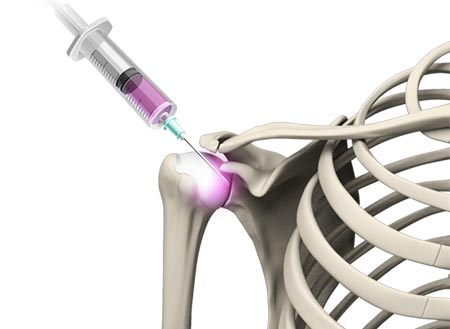For patients with osteoarthritis in the glenohumeral joint (or shoulder joint), treatment options range from “conservative” (non surgical) measures to surgery. Traditional conservative treatments include the well-known rest, ice, activity modification (acronym of RICE), and cortisone (corticosteroid) injections. Surgical management involves shoulder replacement. However, some patients are in a tricky situation where the more commonly known treatments have provided diminishing relief of their symptoms, but surgery is not a good option for them due to timing, medical problems, or concerns regarding recovery time. For these patients, other lesser-known treatments do exist.
One of the simplest conservative treatments for osteoarthritis is the usage of various topical analgesic (pain-relieving) medications. These medications can be obtained over-the-counter and come in a variety of forms. The various types work in slightly different ways to alleviate pain in regions where applied. Some are anti-inflammatory, some use capsaicin/menthol, some are CBD-based, and some use anesthetic similar to that used to numb a region for a local procedure. A thorough exploration of these products may allow a patient to find a product that works well for them.
Physical therapy can also be useful in the treatment of shoulder osteoarthritis. Therapeutic exercise can help patients maintain motion being otherwise compromised by the arthritic changes in the joint. Physical therapists can prescribe exercises to strengthen the surrounding musculature to improve the general mechanics of the shoulder. They can also use modalities like ultrasound, electrical stimulation, dry needling, and soft tissue mobilization to alleviate pain associated with arthritis to further facilitate exercise. It should be noted that therapeutic exercise should only be performed as tolerated as patients with more severe arthritis may find therapy to further aggravate their symptoms.
A treatment option that is becoming more widely accepted is a hyaluronic acid (HA) injection into the shoulder joint. The hyaluronic acid acts like a lubricant in the joint to decrease pain caused by arthritis. These injections are FDA-approved for knees. However, some insurance plans will cover them for “off-label” use in the shoulder. Off label use is allowed, as the doctor is making a decision to use an approved medication in a different manner for which it was approved. It should be noted that FDA approval only relates to the FDA’s approval to advertise or promote a medication. FDA approval does not mean the FDA is stating that something works (this was hard to believe the first time I heard it!). Other patients will choose to pay out of pocket for the HA injection in the hopes of putting off joint replacement surgery or avoiding it altogether.
Another lesser used injection option is a PRP (platelet-rich-plasma) injection. This is a procedure done in a clinic setting. First, the patient has blood drawn that is then spun down in a centrifuge to separate out the platelets from the red blood cells. The platelet plasma (sometimes “rich” sometimes “poor”) is then injected into the joint to help decrease pain and inflammation. Stem cell injections have also grown in popularity (at least on the radio/in advertising). However, the efficacy of this treatment is unproven. No treatment has been proven to re-grow cartilage. At best, these “biologic” treatments are “symptom-modifying” in nature rather than “disease-modifying”. Because of this, and other reasons, they are not covered by insurance.
Radiofrequency ablation (RFA) is a minimally invasive procedure that can help improve pain associated with arthritis in the shoulder. This is a procedure typically performed by an Interventional Radiologist or Physical Medicine and Rehabilitation (PMR) specialist. First, the physician will provide a nerve block in the region of the suprascapular nerve that sends pain signals to the shoulder. If this nerve block successfully alleviates the shoulder pain, the physician will then proceed with a radiofrequency ablation. This is a procedure where radio waves are used to create enough heat in a specific region to destroy a small section of nerves to prevent pain transmission for longer periods of time. If successful, this is a procedure that could be repeated should symptoms recur. This procedure may be covered by insurance.
Though still a surgical approach, sometimes an arthroscopic debridement (or clean out) may be appropriate to consider depending on the degree of arthritis and integrity of the surrounding soft tissues, namely the rotator cuff. However, the relief experienced after a debridement procedure is rather unpredictable as some degree of arthritis persists and can continue to cause discomfort. This procedure may also put off a shoulder replacement, but typically does not definitively alleviate symptoms long-term.
These treatments can be useful in specific situations where replacement surgery is not in the best interest of the patient for whatever reason. Sometimes patients experience enough pain relief with these measures that they forego replacement all together.


